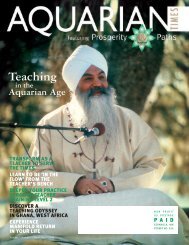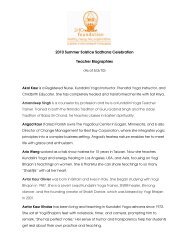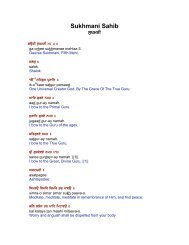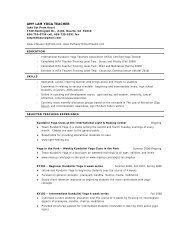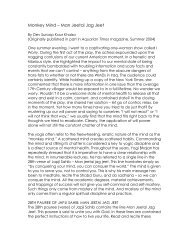July 2006 - 3HO
July 2006 - 3HO
July 2006 - 3HO
Create successful ePaper yourself
Turn your PDF publications into a flip-book with our unique Google optimized e-Paper software.
study using the functional magnetic resonance<br />
imaging technique or fMRI. In that study, Dr.<br />
Lazar reported that a Kundalini Yoga meditation<br />
technique was capable of activating discrete<br />
brain regions distinctly different from those<br />
involved in a control task. She concluded that<br />
“the practice of meditation activates neural<br />
structures involved in attention and control of<br />
the autonomic nervous system,” a conclusion<br />
consistent with the pioneer work of Bagchi and<br />
Wenger decades earlier. Similarly, Dr. Dharma<br />
Singh Khalsa conducted a research study<br />
using another brain imaging technique to<br />
demonstrate that 11 experienced meditators<br />
practicing a Kundalini Yoga meditation called<br />
Kirtan Kriya 3 showed changes in specific<br />
brain regions believed to be associated with<br />
spiritual experience.<br />
Mindfulness Meditation<br />
A significant initiative in meditation research has<br />
been on the study of mindfulness meditation<br />
or Vipassana from the Buddhist tradition. This<br />
technique has become very popular over the<br />
recent past, and the Mindfulness Based Stress<br />
Reduction program inspired by Jon Kabat-Zinn<br />
is being widely used for a variety of medical<br />
and psychological conditions. Research on<br />
mindfulness meditation has been supported<br />
vigorously by the Dalai Lama, who has organized<br />
public and private meetings with scientists<br />
inviting them to participate in meditation<br />
research. He recently gave a major address to the<br />
annual meeting of the Society for Neuroscience<br />
(attended by 14,000 out of the almost 35,000<br />
meeting attendees) in Washington, D.C., which<br />
generated significant media attention. Some<br />
of their ongoing research has focused on brain<br />
imaging studies of Buddhist monks and longterm<br />
practitioners. Recently, Dr. Lazar published<br />
a study that showed that long-term practitioners<br />
of mindfulness meditation showed changes in<br />
brain volume in regions known to be associated<br />
with control of attention and that meditators<br />
appeared to be spared the known reductions in<br />
brain volume associated with aging.<br />
An interesting proposal presented by the mindfulness researchers<br />
has been to use the expert meditation skills of Buddhists as a scientific<br />
instrument. Since lifelong practitioners of Buddhist meditation have<br />
strived to acquire a deep understanding of the workings of the mind and<br />
the subconscious, it is conceivable that this skill can be used in novel<br />
and creative experimental designs to gain insight into how meditation<br />
works and how aberrant psychology might develop.<br />
Research Turns Full Circle<br />
Interestingly, this idea brings us full circle from the beginnings of<br />
research in yoga and meditation, when Western scientific technology<br />
was applied to unravel the meditation experience, to the present<br />
day where Eastern meditation technology is itself being proposed as<br />
an experimental tool.<br />
The burgeoning public interest in yoga and meditation and its<br />
use for alleviating clinical conditions has undoubtedly contributed<br />
to the recent increase in yoga and meditation research. This interest,<br />
In between these two<br />
extremes of yoga<br />
interventions is the use of<br />
specific sets or routines<br />
targeted at a specific<br />
physiological effect or for a<br />
specific clinical condition.<br />
together with the use of modern technological approaches that can<br />
directly observe the effects of these practices on brain function,<br />
suggest that there is much more to come in the field of research in<br />
yoga and meditation. +<br />
Sat Bir Singh is Assitant Professor of Medicine at Harvard Medical<br />
School. He has been practicing the Kundalini Yoga lifestyle for over 30<br />
years and is a certified Kundalini Yoga instructor.<br />
* See Glossary, p. 45.<br />
1 A foundation based in Espanola, New Mexico, whose mission is to<br />
provide health education and instruction in yoga and meditation<br />
to persons with chronic or life-threatening illness, to train health<br />
professionals to use these techniques in their practice, and to conduct<br />
research into the medical effects of Kundalini Yoga.<br />
Visit www.grdcenter.com.<br />
2 Shabad Kriya can be found in the Kundalini Meditation Manual,<br />
available from www.a-healing.com.<br />
3 Kirtan Kriya can be found at www.a-healing.com<br />
and www.spiritvoyage.com.<br />
Dr. Herbert Benson,<br />
director of the<br />
Mind/Body Medical<br />
Institute (left), the<br />
author, and Dr. H.R.<br />
Nagendra, director of<br />
the Vivekananda Yoga<br />
Research Foundation,<br />
at a meeting in<br />
Boston in April, <strong>2006</strong>.<br />
<strong>July</strong>.AT.6.indd 27 6/6/06 2:32:27 PM<br />
27










